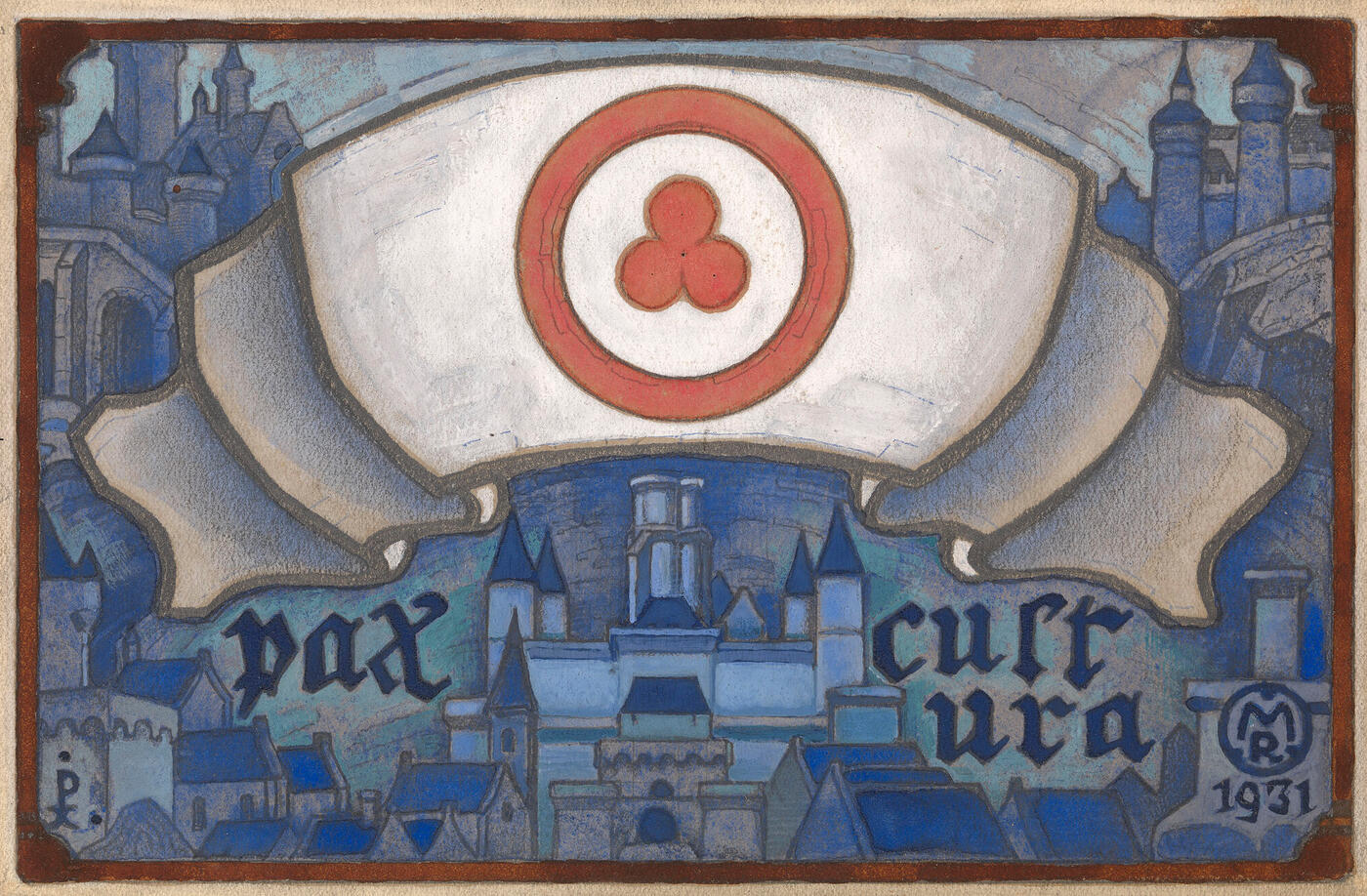5 June 2013 Russian Art Auctions
5 June 2013

* 95. ROERICH, NICHOLAS (1874-1947)
Banner of Peace, signed twice with monograms “NR” and “MR”, inscribed “pax cultura” and dated 1931, further numbered “No. 38” on the reverse.
Pencil and tempera on paper, laid on board, 15 by 23 cm (sheet size), 15 by 23 cm (sheet size).
150,000–300,000 GBP
Provenance: Roerich Museum, New York, USA, 1932–1935.
Collection of Nettie and Louis Horch, USA, from 1935.
Thence by descent.
Private collection, USA.
Exhibited: Roerich Museum, New York (permanent collection), 1932, No. 38.
Literature: Nicholas Roerich’s personal list of paintings from 1931, listed as “No. 38. Znamya mira”.
Roerich Museum, inventory list (1931–1935), listed as “Banner of Peace. 1931. $500, sent to Paris for making
postcard and later transshipped to New-York.”
The present lot is a painting of the Banner of Peace, a symbol of the cause that earned Nicholas Roerich the nomination for the Nobel Peace prize in 1929 and which culminated in the signing of the Roerich Peace Pact by Franklin D. Roosevelt and representatives of twenty Latin American countries at the White House on 15 April, 1935. The Peace Pact called for the Banner of Peace to be flown over important cultural buildings and monuments to protect them from the destruction of war.
The signing of the Peace Pact, “represented the culmination of Roerich’s thirty-six year effort to focus international attention on the importance of preserving and protecting the world’s cultural legacy.” (Jacqueline Decter, Nicholas Roerich, 1989)
The painting portrays the symbol of the Roerich Peace Pact within a banner and with the words, “Pax Cultura” or “Peace through Culture” written underneath. To Roerich, Peace through Culture was an important belief and guided his many artistic works, as well as his teachings and organizational activities. As the artist stated, “Where there is Peace, there is Culture; Where there is Culture there is Peace.” The symbol of the three dots within a circle appears in about ten of Roerich’s known works. This painting is the most official representation and the most widely-known painting of the Banner of Peace worldwide.
The three-dot symbol was also known as the “Red Cross of Culture” and was chosen by Roerich because of its universal nature; it is found in many great cultures of the world. To Roerich, it symbolized the unity of Art, Science and Religion, or the Past, Present and Future in the circle of Eternity. Unlike many of Roerich’s other Symbolist works, where much of the analysis comes from art and historical interpretations, the symbol in the Banner of Peace is extensively documented, including by Roerich himself who wrote that it was found throughout the world and across the millennia.
Roerich had already begun work on the design for the Banner of Peace by the end of the 1920s. He purposefully chose a symbol, which is found in many civilizations in some form or another and which would be understood without preconceptions by the most varied cultural traditions. Roerich’s plans began to come to fruition in September 1931 with the organising of the First International Conference of the Roerich Pact in Bruges, which convened the representatives of more than 20
countries and over 100 delegates from numerous social, academic and cultural organisations.
Banner of Peace was painted by Roerich to coincide with this First International Conference in Bruges, Belgium in 1931, the starting point for international recognition of the Pact. This design is essentially one of the first publications of the Banner in the form in which the international community has adopted it. Thus, the painting presents the unique combination of Roerich the artist and Roerich as the leader of a social movement. It is also an important historical document because it encapsulates an idea that has had and still has many ardent followers.
The work offered here for auction, with its central symbol of three red circles within a red sphere on a white background, illustrates the official sign and distinct banner of the Treaty for the Protection of Artistic and Scientific Institutions and Historic
Monuments, also known as the Roerich Pact, or Pax Cultura.
Already in the wake of World War I, Roerich came forward with appeals to the Russian Tsar to ensure protection of cultural heritage in case of an international conflict. The devastations of the war and Russian Revolution only strengthened his resolve to force the governments of the world to recognize the priority of cultural achievements over narrow geo-political interests. During the years 1928–1935, he envisioned and directed a broad international movement that resulted in the abovementioned Treaty being signed by the United States and twenty other Central and South American countries. The Treaty stated: “The historic monuments, museums, scientific, artistic, educational and cultural institutions shall be considered as neutral and as such respected and protected by belligerents. The same respect and protection shall be due to the personnel of the institutions mentioned above. The same respect and protection shall be accorded to the historic monuments, museums, scientific, artistic, educational and cultural institutions in times of peace as well as in war.”
In the present work, Roerich emphasizes the notion of Culture as the veneration of the Light (Ur), hence the splitting of the word into “cult” and “ura.” The circle with the letters M and R above the year 1931 was the sign of the Roerich Museum in New York and also of the numerous Roerich Societies all over the world that were promoting the Roerich Peace Treaty and its ideas in their respective countries.
We are grateful to Gvido Trepša, Senior researcher at the Nicholas Roerich Museum, New York, for providing catalogue information
Notes on symbols:
* Indicates 5% Import Duty Charge applies.
Ω Indicates 20% Import Duty Charge applies.
§ Indicates Artist's Resale Right applies.
† Indicates Standard VAT scheme applies, and the rate of 20% VAT will be charged on both hammer price and premium.